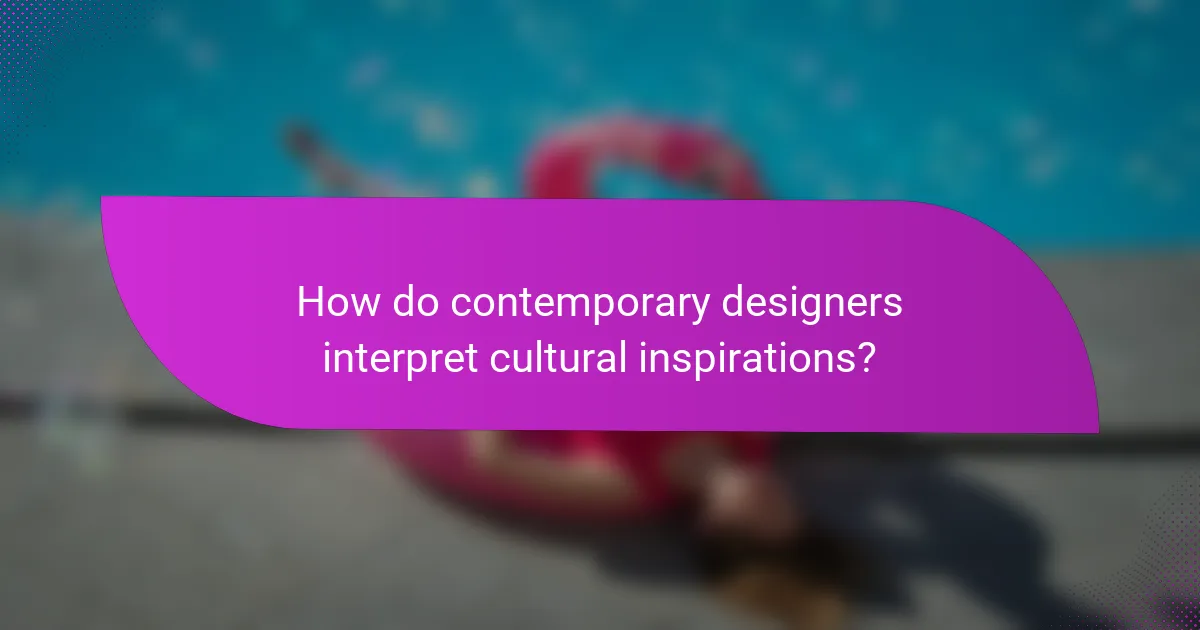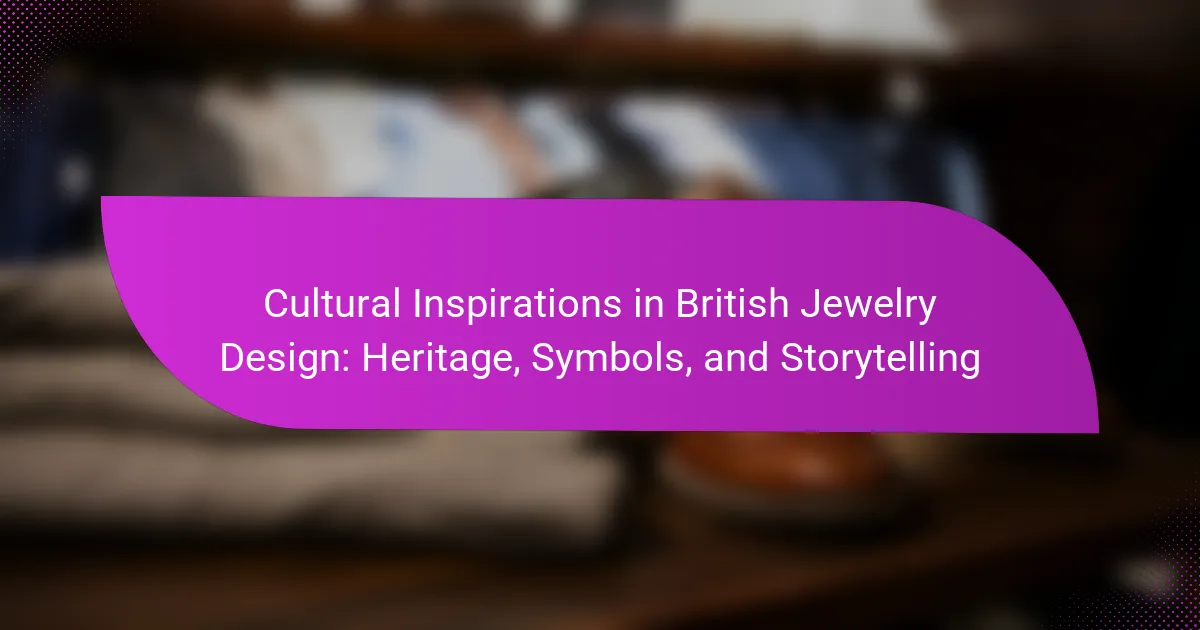Cultural inspirations in British jewelry design encompass a variety of historical and contemporary influences that shape the aesthetics and meanings of jewelry pieces. Key historical movements, such as the Victorian era and the Arts and Crafts movement, have significantly impacted design principles, emphasizing craftsmanship and symbolism. Contemporary designers blend traditional motifs and materials with modern aesthetics, creating a dialogue between past and present while honoring cultural narratives. This practice not only reflects national identity through symbols like Celtic knotwork but also enhances emotional connections for wearers. The integration of diverse cultural elements drives trends in the jewelry market, appealing to consumers seeking meaningful adornments.

What are the cultural inspirations behind British jewelry design?
British jewelry design is influenced by various cultural inspirations. Historical events, such as the Victorian era, shaped design aesthetics. The Arts and Crafts movement emphasized craftsmanship and natural forms. Symbolism plays a significant role, with motifs reflecting national identity. Celtic designs often feature intricate knotwork and nature themes. Additionally, royal influences contribute to opulent styles. British jewelry frequently incorporates local materials, like Scottish agate and Welsh gold. These cultural elements create a rich tapestry of meanings in jewelry design.
How do heritage and history influence British jewelry design?
Heritage and history significantly influence British jewelry design. Traditional craftsmanship is rooted in historical techniques. British jewelry often reflects cultural symbols and motifs. The use of materials like gold and silver traces back centuries. Historical events, such as the Victorian era, inspired elaborate designs. Regional styles are evident in pieces from different parts of the UK. Iconic designs, like the Claddagh ring, showcase cultural narratives. The influence of royal patronage shapes contemporary trends in jewelry design.
What historical events have shaped the aesthetics of British jewelry?
The aesthetics of British jewelry have been shaped by several historical events. The Roman conquest influenced early British jewelry styles, introducing new materials and techniques. The Anglo-Saxon period saw the rise of intricate metalwork and gemstone settings. The Norman invasion brought French influences, leading to the use of enameling in designs. The Victorian era marked significant changes with the introduction of sentimental jewelry, reflecting personal stories and emotions. The Arts and Crafts movement emphasized handcrafted pieces, moving away from industrial production. World War I and II impacted jewelry production, with materials being scarce and designs becoming simpler. Each of these events contributed to the evolving aesthetic of British jewelry, blending cultural influences and historical contexts.
How have traditional crafts contributed to modern British jewelry?
Traditional crafts have significantly influenced modern British jewelry. Techniques such as enameling and metalworking have been passed down through generations. These methods enhance the craftsmanship in contemporary designs. Additionally, traditional motifs and patterns are often reinterpreted in modern pieces. This blend of old and new creates unique jewelry that tells a story. The use of locally sourced materials also reflects a commitment to heritage. Furthermore, the revival of artisanal practices supports sustainability in the jewelry industry. Overall, traditional crafts provide a rich foundation for innovation in modern British jewelry.
What symbols are commonly found in British jewelry?
Common symbols found in British jewelry include the rose, thistle, and shamrock. The rose represents England and is often seen in various designs. The thistle symbolizes Scotland and is frequently incorporated into brooches and pendants. The shamrock represents Ireland and is a popular motif in Celtic jewelry. Other symbols include crowns and lions, which signify royalty and strength. These symbols reflect the rich cultural heritage of the British Isles. Additionally, many pieces feature intricate knotwork, representing eternity and interconnectedness. These motifs are rooted in historical significance and regional identity.
What do specific symbols represent in British culture?
Specific symbols in British culture represent various historical, national, and social meanings. The Union Jack symbolizes the unity of England, Scotland, and Northern Ireland. The rose represents England and is often associated with the War of the Roses. The thistle symbolizes Scotland and is a national emblem. The shamrock is linked to Ireland and signifies Irish heritage. The dragon represents Wales and is a symbol of strength. The lion is a symbol of courage and is often associated with British royalty. Each of these symbols carries significant cultural weight and reflects the identity and history of the respective regions within the UK.
How do these symbols enhance the storytelling aspect of jewelry?
Symbols enhance the storytelling aspect of jewelry by conveying deeper meanings and cultural narratives. Each symbol can represent specific values, beliefs, or historical events. For instance, the use of Celtic knots in British jewelry symbolizes eternity and interconnectedness. This adds layers of significance to the piece beyond its aesthetic appeal. Additionally, symbols can evoke personal stories and memories for the wearer. They create a connection between the jewelry and the individual’s life experiences. Research indicates that jewelry with meaningful symbols can strengthen emotional bonds and enhance personal identity. Thus, symbols play a crucial role in enriching the narrative quality of jewelry.
Why is storytelling important in British jewelry design?
Storytelling is important in British jewelry design because it adds depth and meaning to the pieces. It allows designers to connect emotionally with their audience. Each piece can convey a unique narrative, reflecting cultural heritage and personal experiences. This narrative aspect enhances the value of the jewelry beyond its physical attributes. Historical influences often inspire these stories, linking designs to significant events or traditions. For example, pieces inspired by British folklore can evoke a sense of nostalgia and identity. Furthermore, storytelling can differentiate brands in a competitive market. It creates a memorable experience for customers, fostering loyalty and appreciation for the craftsmanship involved.
How do designers incorporate narratives into their creations?
Designers incorporate narratives into their creations by integrating cultural symbols and personal stories. They often draw inspiration from historical contexts, using motifs that resonate with specific cultural narratives. This approach allows them to create pieces that convey deeper meanings. For example, British jewelry designers frequently reference national heritage in their work. They may use traditional techniques or materials that evoke a sense of history. Additionally, storytelling can manifest through the choice of gemstones, which may symbolize particular emotions or events. Designers also engage with clients to understand personal narratives, tailoring pieces to reflect individual stories. This method enhances the emotional connection between the piece and its wearer. Ultimately, narratives enrich the aesthetic experience and provide a unique context for the jewelry.
What role does personal storytelling play in custom jewelry design?
Personal storytelling is integral to custom jewelry design. It allows clients to express their unique experiences and emotions through personalized pieces. Each custom design becomes a tangible representation of significant life events or memories. This connection enhances the emotional value of the jewelry. Designers often incorporate specific symbols or materials that resonate with the client’s narrative. For instance, a piece may feature birthstones representing family members. This approach not only creates a distinctive product but also fosters a deeper bond between the wearer and the jewelry. Personal storytelling transforms jewelry into meaningful heirlooms, reflecting individual heritage and identity.

How do contemporary designers interpret cultural inspirations?
Contemporary designers interpret cultural inspirations by integrating historical elements into modern aesthetics. They often draw from traditional motifs, symbols, and techniques. For example, British jewelry designers may reference heritage patterns or materials. This approach creates a dialogue between past and present. Designers also adapt cultural narratives to resonate with contemporary audiences. They might combine various cultural influences to create unique pieces. This practice enhances the storytelling aspect of jewelry design. Designers aim to honor cultural significance while innovating in form and function. Such interpretations reflect a broader trend of globalization in art and design.
What trends are emerging in British jewelry design today?
Emerging trends in British jewelry design today include a focus on sustainability and ethical sourcing. Designers are increasingly using recycled materials and ethically sourced gemstones. This shift responds to consumer demand for environmentally friendly products. Additionally, there is a rise in personalization and bespoke pieces. Consumers seek unique items that tell their individual stories. Cultural influences are also prominent, with designs reflecting diverse heritage and symbolism. This trend showcases the rich history of British craftsmanship. Finally, the integration of technology, such as 3D printing, is transforming traditional design processes. These trends highlight a dynamic evolution in the British jewelry industry.
How are modern materials influencing traditional designs?
Modern materials are significantly influencing traditional designs in British jewelry. They introduce new textures, colors, and forms that were previously unattainable. For instance, materials like titanium and carbon fiber offer lightweight yet durable alternatives to traditional metals. These modern materials allow for intricate designs that maintain structural integrity. Additionally, synthetic gemstones provide vibrant colors and affordability, expanding design possibilities. The use of 3D printing technology enables complex shapes and customizations that enhance traditional aesthetics. As a result, contemporary jewelry often blends heritage styles with innovative materials, creating a fusion of old and new. This evolution reflects changing consumer preferences for both sustainability and uniqueness in jewelry design.
What innovative techniques are being used by contemporary designers?
Contemporary designers are utilizing innovative techniques such as 3D printing, sustainable materials, and digital design. 3D printing allows for intricate designs that were previously impossible to create by hand. This technique enables rapid prototyping and customization for individual clients. Sustainable materials are becoming increasingly popular, with designers sourcing recycled metals and ethically sourced gemstones. This approach aligns with growing consumer demand for environmentally friendly products. Digital design tools facilitate the visualization of complex concepts and enhance collaboration among designers. These techniques reflect a shift towards personalization and sustainability in jewelry design, resonating with modern consumer values.
In what ways do cultural exchanges affect British jewelry design?
Cultural exchanges significantly influence British jewelry design by introducing diverse materials, techniques, and motifs. These exchanges lead to the incorporation of global styles, enriching local craftsmanship. For instance, influences from Indian jewelry brought intricate patterns and gemstone usage to British designs. Additionally, cultural collaborations often result in limited edition pieces that reflect a fusion of traditions. Historical events, such as trade routes and colonialism, facilitated the exchange of ideas and aesthetics. The impact of these exchanges can be seen in contemporary British jewelry, which often features multicultural elements. Designers frequently draw inspiration from various cultures to create unique pieces that tell a story.
How do global influences shape local jewelry aesthetics?
Global influences shape local jewelry aesthetics by introducing diverse styles and techniques. These influences come from trade, travel, and cultural exchange. For example, the Silk Road facilitated the sharing of materials and designs between East and West. As a result, British jewelry incorporates elements from various cultures. This includes the use of gemstones and motifs inspired by global traditions. Additionally, contemporary trends often reflect international fashion movements. The fusion of these global elements creates unique local expressions. Overall, local jewelry aesthetics evolve through the integration of global inspirations.
What collaborations between cultures have resulted in unique jewelry pieces?
Collaborations between cultures that have resulted in unique jewelry pieces include the fusion of British and Indian design elements. The British Raj period saw the introduction of Indian gemstones into Western jewelry. This period led to the creation of pieces that combined traditional British styles with intricate Indian craftsmanship.
Another example is the collaboration between Native American and European artisans. This partnership produced jewelry that features European metalworking techniques and Native American motifs.
In contemporary times, designers often draw inspiration from African, Asian, and Indigenous cultures. These collaborations result in pieces that celebrate diverse heritage and storytelling through unique designs.
The use of materials, such as African beads or Asian silks, further enhances these culturally inspired pieces. Such collaborations highlight the rich tapestry of global influences in jewelry design.

What are the practical applications of cultural inspirations in jewelry design?
Cultural inspirations in jewelry design are applied to create unique pieces that reflect heritage and identity. Designers utilize symbols and motifs from various cultures to convey stories and meanings. This practice enhances the emotional connection between the wearer and the jewelry. For example, Celtic designs often feature knots and patterns that symbolize eternity. Similarly, Native American jewelry incorporates specific symbols that represent nature and [censured]. These inspirations not only celebrate cultural diversity but also attract consumers seeking meaningful adornments. Additionally, cultural inspirations can drive trends in the jewelry market, influencing styles and consumer preferences.
How can understanding cultural inspirations enhance jewelry marketing?
Understanding cultural inspirations can significantly enhance jewelry marketing. Cultural inspirations provide a rich narrative that resonates with consumers. They connect jewelry pieces to specific traditions, stories, and values. This connection can create emotional appeal, making products more desirable. For instance, jewelry inspired by historical events or cultural symbols can attract customers seeking authenticity. Additionally, incorporating cultural elements can differentiate brands in a competitive market. Research shows that consumers are more likely to purchase products that reflect their cultural identity. This trend emphasizes the importance of cultural relevance in marketing strategies.
What strategies can designers use to communicate their cultural stories?
Designers can use visual symbolism, storytelling techniques, and cultural motifs to communicate their cultural stories. Visual symbolism involves incorporating recognizable symbols that resonate with specific cultural narratives. Storytelling techniques can include creating narratives around the design process and the significance of materials used. Cultural motifs, such as patterns or colors associated with a heritage, can enhance the emotional connection to the piece. Research indicates that jewelry that reflects cultural identity can foster a sense of belonging and pride among communities. For example, the use of Celtic designs in British jewelry connects to historical narratives and cultural heritage.
How can cultural themes attract specific target audiences?
Cultural themes can attract specific target audiences by resonating with their values and experiences. When jewelry designs incorporate cultural symbols, they evoke a sense of identity and belonging. For example, British jewelry often uses motifs from local history, appealing to consumers who value heritage. This connection can increase emotional engagement with the product.
Studies show that consumers are more likely to purchase items that reflect their cultural background. A survey by the Pew Research Center indicated that 72% of individuals prefer brands that align with their cultural identity. Additionally, storytelling in jewelry can create a narrative that captivates specific demographics.
By using cultural themes, designers can effectively target niche markets, enhancing brand loyalty and customer satisfaction.
What tips can designers follow to incorporate cultural inspirations effectively?
Designers can effectively incorporate cultural inspirations by conducting thorough research on the culture they wish to represent. Understanding historical context is crucial for authenticity. Engaging with cultural practitioners can provide deeper insights and perspectives. Designers should also consider the symbolism behind cultural elements to ensure respectful representation. Collaborating with cultural communities fosters trust and enriches the design process. Testing designs with cultural representatives can help identify any misinterpretations. Lastly, continuous learning about cultural dynamics ensures designs remain relevant and respectful.
What resources are available for researching cultural symbols and heritage?
Resources available for researching cultural symbols and heritage include academic databases, libraries, and online archives. Academic databases like JSTOR and Google Scholar provide access to peer-reviewed articles and research papers. University libraries often have extensive collections of books and journals on cultural studies. Online archives, such as the Digital Public Library of America, offer digitized materials related to cultural heritage. Museums and cultural institutions also publish research and resources on their websites. Additionally, ethnographic studies and anthropological research provide insights into cultural symbols. These resources collectively support comprehensive research into cultural symbols and heritage.
How can designers ensure authenticity in their cultural representations?
Designers can ensure authenticity in their cultural representations by engaging with the communities they represent. This involves conducting thorough research to understand cultural contexts and meanings. Collaborating with cultural experts and community members enhances accuracy and respect. Designers should avoid stereotypes and misinterpretations by valuing diverse perspectives. Using traditional techniques and materials can also support authenticity. For instance, jewelry made with locally sourced materials reflects genuine cultural practices. Documenting the cultural significance behind design choices provides transparency. This approach fosters trust and appreciation for the culture being represented.
Cultural Inspirations in British Jewelry Design focuses on the significant influence of heritage, historical events, and cultural symbols on the aesthetics and craftsmanship of British jewelry. The article explores how traditional techniques and materials shape contemporary designs, highlighting the importance of storytelling and personal narratives in creating meaningful pieces. Key topics include the impact of historical movements, the role of symbols such as the rose and thistle, and the integration of modern materials and techniques in jewelry design. Additionally, it discusses the importance of authenticity and cultural representation in the creation and marketing of jewelry.
